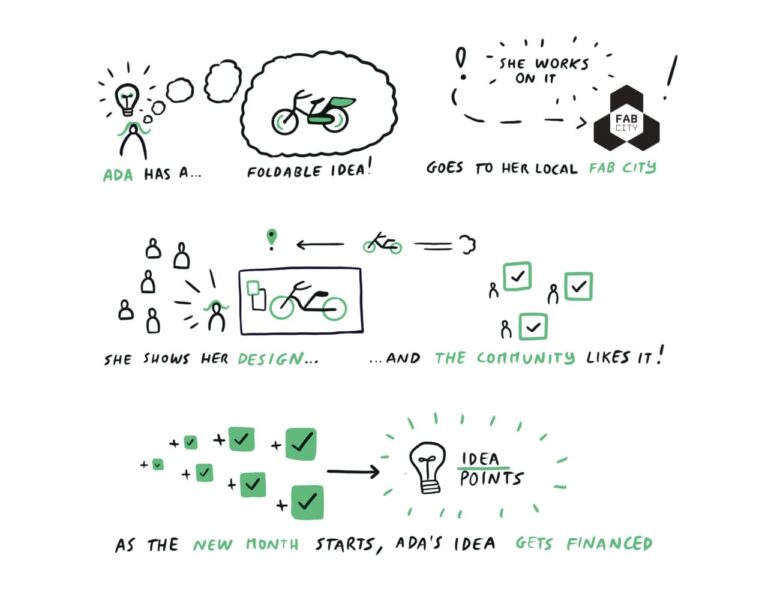Creative Flows
The New Economic Model for Fab Cities and Fab Labs
The Fab City Operating System presents a revolutionary economic model called Creative Flows, supporting the sharing, tracking, and tracing of open hardware in a standardized form.
This enhances collaboration and promotes fair agreements directly between users in a secure network.
Globally connected productive communities are empowered to discover, remix, and improve designs and technologies like never before.
This economic model, utilizing blockchain technology, facilitates fair revenue distribution based on contributions and agreements.
Creativity and Circular Economy
The monetary circuit we are developing assumes recognition not only of collective work but also of positive externalities due to the new knowledge that arises from the creative atmosphere and the sharing of projects in open space. Ongoing activities positively affect each other.
Also, a project owes part of its success to the failing attempts at developing other projects in the same beautiful place.
Therefore, the value of the work done must also take into account the time it takes to establish a creative atmosphere, which we consider a positive externality (E+). If we give a measure to these E+, we will have a chance to recognise the value added by all participants.
The need to keep the creative atmosphere alive and to take positive externalities into account leads to the proposal of a transactional scheme organized as Creative Flows.
Incoming amounts paid for a Fab City product go to a common bank. The bank will then redistribute these amounts to participants based on the activity performed.
Using idea/strength tokens NFTs is instrumental in avoiding accumulation and thus decreasing the transactional potential associated with tokens; there is a cyclical resetting of their value inspired by the demurrage principle.
A common internal fungible token (FT) currency unit is created at every cyclical reset.
Each person can decide whether to take these resources and reinvest them in the ecosystem to invent new projects or to redeem them and use them personally. In the likely case in which a private company would be responsible for the sale and redistribution of products developed by people in a Fab City, then it would pay back liquidity to a legal entity (the Fab City Association) which then applies its internal redistributive logic as Creative Flows.
The people participating in the creative activities of a Fab City are also the beneficiaries of a redeemable fungible token (FT). Still, they cannot accumulate the token above a certain threshold, or the principle of demurrage is triggered. The Fab City manages cyclical demurrage to become a forced reinvestment above a profit threshold.
The principle of reciprocity in Creative Flows can be expressed as “commoning yields to commoning,” believing that only commoning nurtures the creative atmosphere.


How Does It Work?
We based our implementation on the organization of meaningful data and interactions for which the FabCity OS constitutes an advanced accounting system. We organize the record of all exchanges according to a Resource-Event-Agent accounting system (REA) whose data rests on a Graph database that documents all relationships and offers an easy way to search through them.
Then we apply the Valueflows vocabulary as one possible semantic organization of this data. By doing so, we use “points” to the interactions between Agents, for instance, the agreed offer and provision of contributions to projects.
The points are of two different kinds to map two different dimensions in Keynesian economics:
💡
Idea
points
Debt
💪
Strength
points
Credit
This system does not represent its liquidity by points: they are not the money that pays for the participant’s time and fuels its economic growth. We may define 💪 strength and 💡 idea points in cryptonomics terms as “non-fungible tokens” that are “burned” using a “peg” linking them to an amount of money (or fungible tokens) at every new cycle.
The pegged value will vary depending on the liquidity available to the collective, and in case of scarcity, it may be mitigated by an existing federation. In any case, the collective administration of this liquidity rate will help the bootstrap of new collectives while keeping a balance through basic income based on shared savings.
We realized this implementation within our FabCity OS software by creating points when certain exchanges take place as approved contributions into the graph. The software can then visualize the graph of contributions related to a given project that took place within a certain amount of time. Based on that visualization and other flexible data models obtained via GraphQL queries, the collective can decide to assign a “social proof of work” to participants.
Creative Flows and FabCity OS transform the traditional economic model, offering a decentralized and equitable solution.
If you need more information about the project, fab labs or related events please fill out the form.
To keep up to date with our activities, events and to be informed about upcoming webinars, subscribe to our newsletter now!
CONSORTIUM PARTNERS
FUNDED BY
Project funded by the European Regional Development Fund (ERDF) in the context of the INTERFACER Project
Powered by Oxjno
